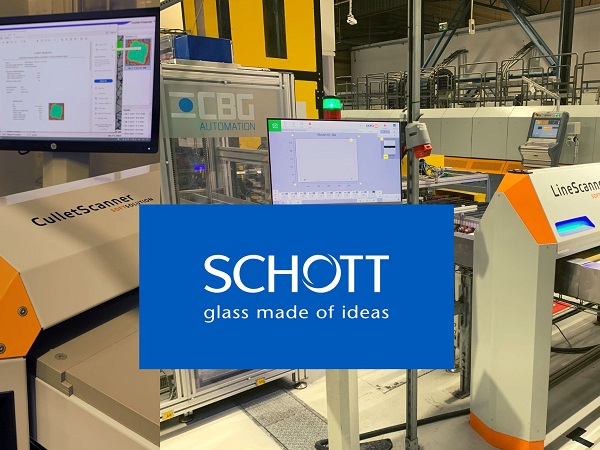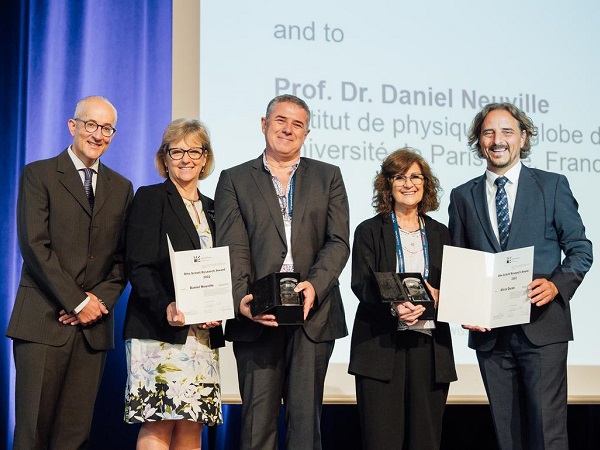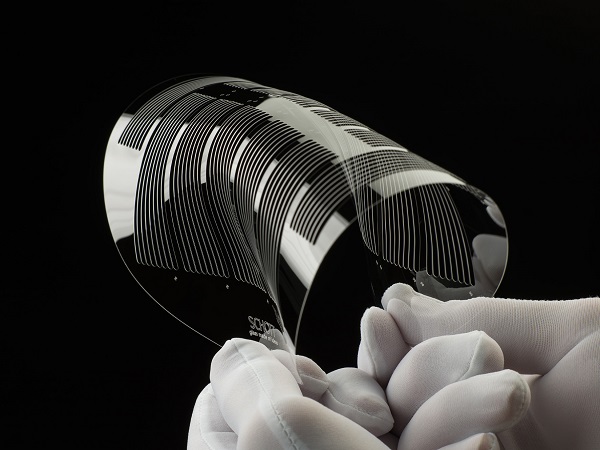Date: 9 December 2014
This process is used to achieve an appearance that closely resembles the period in which the respective buildings were actually built.The restoration glasses that SCHOTT offers have also received European technical certification and therefore meet the demands of monument conservationists as well as building owners and users. Ulrich Huber, Sales Manager for Architectural Glasses at SCHOTT Advanced Optics, will be giving a presentation on this topic at the event “Denkmal und Energie” to be held in Osnabrück, Germany, on December 8..jpg)
When you look through restoration glasses such as RESTOVER® plus from SCHOTT, the even edges behind them look wavy. Photo: SCHOTT.
“Based on historic technologies, the Fourcault process uses molten glass that is mechanically drawn upwards between several pairs of rollers on different floors of the building and then slowly cools them down. The continuous glass ribbon is finally cut into individual sheets at the top of the drawing shaft,” explains Ulrich Huber, Sales Manager for Architectural Glasses at SCHOTT Advanced Optics, in reference to how the drawing process works. “The special characteristics of the restoration glasses are achieved by using this historically authentic production process,” Huber adds. The typical impression of a machine-drawn glass is characterized by deviations in terms of its thickness and flatness. Melting-related traits such as bubbles, nodes and stones within certain tolerances also contribute to the characteristic look of machine-drawn glasses. At the same time, all of the characteristics of glass can be influenced during the production process and be made to closely match the appearance of the original historic glass..jpg)
Thanks to the insulating glass TIKANA®, the external appearance of the Van de Velde building at Bauhaus University in Weimar now resembles the aesthetics of the period in which it was used by the State Bauhaus in Weimar. Photo: SCHOTT.
Glasses that are manufactured using the Fourcault process differ from the float glasses that are used today mainly in terms of how they can be looked through and their outer appearance. When you look through machine-drawn restoration glasses, the even edges behind them look wavy. Floated glasses on the other hand leave an undistorted impression. When you look at the surface of a machine-drawn restoration glass, you will see unevenness, while a floated glass looks flat.
Furthermore, all SCHOTT restoration glasses can be processed into insulating glass, laminated glass or safety glass. When it came to renovating the Van de Velde building at Bauhaus University in Weimar, insulating glass that consisted of an outer pane of TIKANA® glass was used. The external appearance of the building now resembles the aesthetics of the period in which it was used by the State Bauhaus in Weimar. TIKANA® was particularly well suited for this project because its slightly uneven surface fits in harmoniously with the buildings of the classical modern period. Besides its standard thickness of 4 mm, this glass can also be manufactured in 6 mm thickness and in lengths of up to 3,000 mm..jpg)
In Comparison to RESTOVER® plus, floated glasses leave an undistorted impression. Photo: SCHOTT.
In addition to TIKANA® glass, the restoration glass RESTOVER® is also manufactured using the Fourcault process. It resembles the window glass manufactured around the turn of the century. Thanks to its relative thinness, it can easily be installed in historic window frames and profiles. With RESTOVER® light, a more lightly structured surface version that resembles mouth-blown glass is now also available. RESTOVER® plus, on the other hand, has a more dominant structure..jpg)
When it came to renovating the Van de Velde building at Bauhaus University in Weimar, insulating glass that consisted of an outer pane of TIKANA® glass was used.
GOETHEGLAS is yet another restoration glass from SCHOTT, a colorless, drawn glass with an irregular surface full of character that was used predominantly in the 18th and 19th century. It is also suited for use as outdoor glazing, for instance to protect precious lead glazings from environmental and weather damages.
SCHOTT’s complete product line includes not only machine-drawn restoration glasses, but also several high-quality architectural glasses: the decorative clear glass ARTISTA® for indoor and outdoor applications, the highly transparent, colorless flat glass RIVULETTA® with a surface structure that runs parallel on one side, the semi-transparent, anti-reflective glass MIRONA® and the dichroitic NARIMA® effects glass. The product line also includes coated specialty glasses such as anti-reflective AMIRAN® and MIROGARD®. Furthermore, SCHOTT offers the radiation shielding glass RD 50® for use in buildings, X-ray rooms, and operating rooms as a transparent alternative to other shielding materials.
Other information is available under: http://www.schott.com/architecture/english/products/index.html
AMIRAN®, ARTISTA®, MIROGARD®, MIRONA®, NARIMA®, RESTOVER®, RIVULETTA®, TIKANA® and RD 50® are registered trademarks of SCHOTT AG.
SCHOTT is an international technology group with 130 years of experience in the areas of specialty glasses and materials and advanced technologies. SCHOTT ranks number one in the world with many of its products. Its core markets are the household appliance, pharmaceutical, electronics, optics and transportation industries. The company is strongly committed to contributing to its customers’ success and making SCHOTT an important part of people’s lives with high-quality products and intelligent solutions. SCHOTT is committed to managing its business in a sustainable manner and supporting its employees, society and the environment. The SCHOTT Group maintains close proximity to its customers with manufacturing and sales units in 35 countries. Its workforce of 15,400 employees generated worldwide sales of 1.84 billion euros for the 2012/2013 fiscal year. SCHOTT AG, with its headquarters in Mainz (Germany) is owned by the Carl Zeiss Foundation.







Add new comment